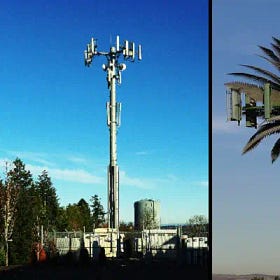Dr. Devra David talks about Mobile Phone and Wireless Radiation in this important presentation.

Dr. Devra Davis is founder and President of Environmental Health Trust, a scientific think tank that publishes research and educates policymakers and the public on environmental health hazards. She is currently Visiting Professor of Medicine at The Hebrew University Hadassah Medical School, Jerusalem, Israel, and Ondokuz Mayis University Medical School, Samsun, Turkey. Davis was Founding Director, Center for Environmental Oncology and the University of Pittsburgh Cancer Institute and founding director of the Board on Environmental Studies and Toxicology of the U.S. National Research Council, National Academy of Sciences.
See some of our previous post on the planned 5G Death Grid. Full video below with summary and transcript.
Death by Cell Towers? Are the 5G Towers Safe
They are getting creative in how they hide these 5G Towers, but in other locations there is no hiding these monstrosities and their death rays. It is important to note that there are two sets of exposure limits set by the FCC and two groups affected; the well informed workers and the poorly informed unassuming public. And those exposure limits were set …
Are the Spike Proteins causing Radiation Poisoning Sickness?
Are Spike Proteins Radioactive Particles with Betty Martini and Jeff Rense? That is the theory being presented and the interesting point to note here is that Radiation Sickness symptoms look very similar to severe flu symptoms. But first what to make of the rumor going around about Eggs and Spike Proteins and a connection to the Egg Farms being burnt do…
Are those 5G Kill Grid Towers in NYC just like Westworld Season 4?
Listen now (16 mins) | When they can no longer control the hungry homeless hordes, what will THEY do? According, to Mike Adams, THEY might activate the 5G Kill Grid Towers such as the 2000 being installed around NYC. Remember the foundation was already laid with the Vaccines as the delivery system for the installation of the Ai operating system. Just another silly coincidence…
This was the first lecture I ever watched on cellphone radiation and should be required viewing by every single parent who gives a cellphone to their child or teenager. It's such an important lecture that I hope everyone can carve out an hour to watch. Dr Davis has been sounding the alarm on this issue for years and deserves a lot of credit for bringing attention to it. She is the founder of Environmental Health Trust as well.
The Truth About Mobile Phone and Wireless Radiation
Section Overview: Dr. Deborah Davis discusses the topic of mobile phone and wireless radiation, emphasizing that truth is relative in science. She highlights the increasing number of cell phones and wireless devices in use worldwide and raises concerns about public health and environmental effects.
Importance of Understanding Mobile Phone Radiation
Over 6 billion cell phones and 8 billion wireless transmitting devices exist globally.
Anticipation for over 50 billion devices forming the Internet of Things.
Limited knowledge about public health and environmental effects.
Speaker's Background
Dr. Deborah Davis has expertise in studying magnetic radiation from mobile phones and wireless transmitting devices.
Founding director of Center for Environmental Oncology at University of Pittsburgh Cancer Institute.
Founded nonprofit organization Environmental Health Trust for research on environmental impact on health hazards.
Similarities with Past Scientific Debates
Draws parallels with past debates on tobacco safety on airplanes.
Raises legitimate questions about mobile phone radiation safety that require further research.
Importance of Research in Mobile Phone Radiation
Section Overview: Dr. Deborah Davis highlights the importance of research in understanding the effects of mobile phone radiation. She mentions her involvement in the committee that recommended banning smoking on airplanes and emphasizes the need for more research in the field of mobile phone radiation.
Importance of Research
Draws parallels with past debates on tobacco safety on airplanes.
Emphasizes the importance of research in understanding mobile phone radiation effects.
Notes limited new research being conducted in this field.
Misconceptions about Cell Phone Safety
The speaker initially believed that using cell phones was only important for scientific purposes.
They found it fun to be able to contact people at any time and didn't think there could be any problems with it.
Importance of Safety Information
The speaker acknowledges that information is routinely sent to people regarding cell phone safety.
They ask the audience how many of them have an iPhone and instruct them to check their phone settings for safety information.
Telstra, a telecom company, is praised for providing safety information to its users.
The speaker emphasizes the need for better dissemination of information on reducing exposure to mobile phone radiation.
Why We Need to Reduce Exposure
Section Overview: This section focuses on why it is necessary to reduce exposure to mobile phone radiation and highlights outdated standards.
Outdated Standards
Initially, standards for cell phones were set based on avoiding heat as the only concern.
These standards were established using a large person's head as a reference point, which doesn't account for variations in head size among different individuals.
Lack of Evaluation for Safety in Developing Brains
The current standards do not consider the potential risks posed by mobile phone radiation on young developing brains.
The speaker mentions that Telstra advises using hands-free devices and keeping mobile phones away from the head and body to reduce exposure.
Understanding Mobile Phone Radiation Frequencies
Section Overview: This section provides an overview of different types of radiation frequencies emitted by various devices.
Frequency Comparison
Different devices such as FM radio, microwave ovens, mobile phones, and Wi-Fi devices use similar frequencies.
The power and emission characteristics differ between these devices.
Importance of Pulse Signals
Mobile phones and Wi-Fi devices emit pulse signals that are considered biologically important.
The irregularity of the pulse signal may have a greater impact on biological systems than continuous wave signals.
Variations in Signal Properties
Section Overview: This section explains how variations in signal properties can influence their effects on biological systems.
Signal Properties
Frequency, amplitude, and pulse characteristics influence the properties of a signal.
These variables determine how a signal can affect a biological system.
Importance of Irregular Pulse Signals
Irregular pulse signals emitted by mobile phones for extended periods may have significant biological implications.
Continuous wave signals have therapeutic effects used in medical applications.
Section Overview: The speaker discusses the importance of exposure to radiation and how it can vary based on factors such as age, size, and skin properties. They also mention the need for three-dimensional modeling to understand radiation dose in different parts of the body.
Radiation Exposure Variation
Exposure to radiation can vary based on factors such as age, size, and skin properties. For example, even with the same exposure, individuals with different skin types may absorb different amounts of ultraviolet light.
Two-dimensional modeling from the past suggested that children and smaller adults might absorb more radiation than larger adults. However, newer three-dimensional modeling techniques have shown that smaller heads may proportionally absorb more radiation.
Anatomically-based models using MRI scans have been used to demonstrate the difference in radiation dose in heads of different ages and sizes.
The Virtual Family system is a powerful tool used for setting standards in medical devices but is not utilized for mobile phone standards.
Section Overview: The speaker presents modeled microwave radiation doses in different parts of a young child's head when exposed to a mobile phone. They also discuss the potential effects on reproductive organs.
Microwave Radiation Dose Modeling
Modeled microwave radiation dose of a six-year-old shows higher levels of exposure in frontal and temporal lobes, eyes, and cheek.
The simulation demonstrates that there can be some exposure into sensitive areas of a young child's head.
Another simulation shows the potential exposure to reproductive organs (gonads) and bone marrow when carrying a mobile phone in the pocket.
This kind of work needs to be done to better understand the potential effects of mobile phone radiation.
Section Overview: The speaker mentions recommendations made by Consumer Reports regarding keeping phones away from pockets due to exceeding exposure guidelines. They also discuss collaboration with Yale University and experts in studying the effects of mobile phone radiation on pregnancy.
Recommendations and Collaboration
Consumer Reports recommends not keeping a phone in the pocket due to potential exposure exceeding tested guidelines.
Collaboration with Yale University and over a hundred physicians and experts is ongoing to study the effects of mobile phone radiation on pregnancy.
The Baby Safe Project and Radiation Exposure
Section Overview: In this section, the speaker discusses the Baby Safe Project developed with colleagues at Yale to advise pregnant women on protecting their abdomen from mobile phone radiation. The speaker also mentions that devices like iPads and tablets should not be held in the lap of little children due to radiation exposure.
Protecting Pregnant Women and Children from Radiation Exposure
The skin is completely permeable to radiation exposure, so it is important for pregnant women to protect their abdomen from mobile phone radiation.
Devices like iPads and tablets are not approved to be held in the lap of little children due to radiation exposure.
The educational technology sector and public health research need better communication as they are not considering the potential risks of giving children two-way microwave radiating devices.
If children must use such devices for learning purposes, they should be put on airplane mode to avoid sending and receiving signals.
Modeling Radiation Exposure
Section Overview: This section focuses on modeling radiation exposure using MRI scans. The speaker shares a model created with one millimeter voxels and demonstrates how radiation penetrates different parts of the body.
Modeling Radiation Exposure
A model was created using MRI scans with one millimeter voxels.
After a six-minute call, the peak radiation reaches almost both eyes in a three-year-old child's brain.
While one call may not cause immediate harm, it raises concerns about cumulative impact over time.
Evaluating and studying the long-term effects of this kind of exposure is challenging because there is no control group available for comparison.
Lack of Research on Infants, Toddlers, and Young Children
Section Overview: This section highlights the lack of research on the effects of mobile phone radiation on infants, toddlers, and young children. The speaker emphasizes the need for further research in this area.
Lack of Research on Children and Pregnancy
There is almost no research currently underway regarding the effects of mobile phone radiation on infants, toddlers, and young children.
More than half of young children today have access to these devices, making it difficult to establish a control group for comparison.
A significant number of children as young as two years old can order their own apps on mobile devices.
The lack of research in this area underscores the importance of developing studies to understand potential risks.
Concerns about Device Usage in Young Children
Section Overview: This section discusses concerns about device usage in young children and highlights the need for parents to reconsider giving devices like iPads to very young children.
Device Usage in Young Children
Some young children have become dependent on iPads and refuse to go to the bathroom without them.
Parent magazine has referred to iPads as "the best babysitter," which raises concerns about radiation exposure.
Parents should put devices on airplane mode when giving them to their children and be aware that they are exposing them to two-way microwave radio signals.
Babies' Behavior with Devices
Babies have a natural tendency to put objects in their mouths as part of their learning process.
The video shows a baby putting an electronic device into its mouth, highlighting how easily babies can come into contact with potentially harmful radiation-emitting devices.
Microwave Oven Origins and Experimental Studies
Section Overview: This section briefly discusses the origins of microwave ovens and mentions that experimental studies have been supported by NATO.
Microwave Oven Origins and Experimental Studies
Radar research led to the discovery of microwave cooking, resulting in the invention of the first microwave oven called "radar range."
Experimental studies on radar and microwaves have been supported by NATO.
Section Overview: This section discusses the effects of prenatal exposure to mobile phone radiation on animals and humans.
Effects of Prenatal Exposure to Mobile Phone Radiation on Animals
Animals were prenatally exposed to mobile phone radiation under controlled conditions using a computer simulation. (t=1638s)
Liver malondialdehyde, a measure of peroxidation and liver damage, was significantly higher in animals prenatally exposed to mobile phone radiation compared to controls. (t=1685s)
Studies conducted in Turkey showed that prenatal exposure to mobile phone radiation resulted in fewer cells in the hippocampus, an important part of the brain responsible for memory and other cognitive functions. (t=1731s)
Newborn rats that were prenatally exposed to mobile phone radiation took three times longer to find their way out of an experimental maze and made twice as many errors compared to controls. (t=1796s)
Effects of Prenatal Exposure to Mobile Phone Radiation on Human Sperm
Studies conducted in Australia, India, and the United States have shown that sperm exposed to mobile phone radiation had reduced vitality, mobility, and increased mitochondrial DNA damage compared to controls. (t=1864s)
The evidence linking mobile phone radiation and sperm damage is considered causal by experts in male fertility. (t=1914s)
Men who keep cell phones in their pockets for longer durations have been found to have lower sperm counts. (t=1985s)
The Impact of Testosterone and DNA Damage
Section Overview: This section discusses the role of testosterone in both males and females, with males requiring higher levels. It also mentions that microwave radiation exposure can cause DNA damage, leading to lower fertility. A case report is presented to show the effects of long-term cell phone use in a bra.
Testosterone and DNA Damage
Testosterone is an important hormone for both men and women, but men require higher levels.
Microwave radiation exposure can lead to DNA damage, as measured by certain enzymes.
Offspring from individuals exposed to microwave radiation had lower fertility.
Effects of Cell Phone Use
Cell phones do not generate heat like microwave ovens but can penetrate through fat and fluid-containing objects.
Women who keep cell phones in their bras may be at risk due to proximity to breast tissue.
A case report from 2009 shows a woman who used her cell phone in her bra for hours daily for ten years developed tumors under the antenna of the phone.
There are also cases of men developing unusual skin cancers or growths when keeping their phones in their breast pockets.
Unusual Breast Cancer Cases and Precautionary Advice
Section Overview: This section highlights unusual breast cancer cases related to cell phone use. It emphasizes the need for precautionary advice due to potential risks. Additionally, prenatal exposure to mobile phone radiation has been found to have significant effects on mice behavior.
Unusual Breast Cancer Cases
Unusual breast cancer cases have been observed in individuals who kept their cell phones close to their chests.
These cases include young women without family history or inherited defects associated with increased breast cancer risk.
Tumors often develop under the antenna of the phone, sometimes located centrally on the chest.
Precautionary Advice
While more research is being conducted, precautionary advice is necessary to protect public health.
The Baby Safe Project, in collaboration with Yale University and other institutions, aims to study the prenatal impact of mobile phone radiation.
The World Health Organization (WHO) classified mobile phone radiation as a possible human carcinogen in 2011 but additional research and pragmatic measures to reduce exposure are still needed.
Prenatal Effects on Mice Behavior
Mice exposed to mobile phone radiation prenatally have shown significant effects on their behavior as adults.
These effects include hyperactivity, worse memory, increased anxiety, and reduced fear.
World Health Organization's Review and Lack of Research
Section Overview: This section discusses the World Health Organization's review of evidence regarding mobile phone radiation as a possible human carcinogen. It also highlights the lack of ongoing research in this area.
WHO Review and Pragmatic Measures
In 2011, the WHO reviewed all available evidence and classified mobile phone radiation as a possible human carcinogen.
The review emphasized the importance of conducting additional research and implementing pragmatic measures to reduce exposure.
Lack of Ongoing Research
Currently, there is a lack of ongoing research on brain cancer and mobile phone radiation by both the WHO and other organizations.
Environmental Health Trust has published articles suggesting that mobile phone radiation is a probable human carcinogen based on newer studies showing an increased risk of developing brain cancer with prolonged use.
Section Overview: In this section, the speaker discusses the challenges of conducting research on the link between mobile phone use and brain cancer. They highlight the limitations of relying on self-reported data and emphasize the need for real data from telecom industry records.
Challenges in Researching Mobile Phone Use and Brain Cancer
The speaker mentions that comparing people with brain cancer to those without the disease and asking them to recall their phone usage is not a precise science due to exposure misclassification.
This method biases towards the null hypothesis and is considered a poor way of conducting research.
The cooperation of telecom industry is needed to obtain billing records as real data instead of relying on self-reporting.
Obtaining such data is challenging, especially in countries like the United States where it is not feasible to collect detailed phone usage information.
Section Overview: In this section, the speaker discusses how changes in mobile phone usage patterns over time can impact research findings. They also mention an interesting observation from France regarding increased brain cancer cases among individuals who started using phones regularly before age 20.
Impact of Changing Mobile Phone Usage Patterns
If people start using phones regularly before age 20, there was a higher incidence of brain cancer after ten years compared to those who started later.
Despite this observation, there is currently no increase in brain cancer cases found in the general population today.
The speaker explains that brain cancer takes a long time to develop, as evidenced by studies conducted on survivors of World War II bombings who did not show an increase until forty years had passed.
The number of people using cell phones today has significantly changed compared to previous years, with unlimited talk and text plans becoming more common.
Most epidemiologic studies do not find an increased risk of brain cancer from mobile phone radiation until heavy use for at least ten years.
The definition of a cell phone user in these studies is someone who makes one call a week for six months, which further highlights the challenges in studying rapidly changing technology.
Section Overview: In this section, the speaker discusses the difficulties of conducting studies on rapidly changing technology and the lack of modeling for infants and toddlers' exposure to mobile phones. They also mention the work of colleagues in India regarding honeybees and their potential sensitivity to mobile phone radiation.
Challenges in Studying Rapidly Changing Technology
The speaker acknowledges that studying something as rapidly changing as mobile phone technology poses significant challenges.
The way people use phones has evolved, with unexpected usage by infants and toddlers becoming more common.
There has been no previous modeling of the brain's effects until now, highlighting the need for research in this area.
The speaker shares the work of colleagues from India who studied honeybees under controlled conditions using mobile phones.
Exposing honeybees to an operating mobile phone resulted in worker bees not returning to the hive, which could have implications for agriculture that relies on honeybees for pollination.
While there are other factors affecting honeybee populations such as climate and pesticides, mobile phone radiation could be another factor worth investigating.
Section Overview: In this section, the speaker mentions inconsistent results in studies related to mobile phone radiation. They emphasize that they are not selectively presenting positive findings but rather acknowledging the varying outcomes observed.
Inconsistent Results in Studies
The speaker acknowledges that there are many inconsistent results when it comes to studying the effects of mobile phone radiation.
They clarify that they are not cherry-picking positive findings but rather presenting an overview of different outcomes observed in research studies.
Exposures and Sponsored Research
Section Overview: This section discusses the influence of sponsored research on the topic of exposures to electromagnetic waves. It highlights the challenges of having a neutral playing field when research is funded by interested parties.
Sponsored Research Bias
The speaker mentions that sponsored research can induce publication bias, where the findings are influenced by those who fund the studies.
In countries including the United States, there has been a significant amount of sponsored research within the government itself.
The director of the Federal Communications Commission in the United States was previously associated with the cellphone telecommunications industry.
Lack of Action and Calls for Research
The US Congress has repeatedly called for studies on mobile phone radiation since 1993, but each time, more research is requested instead of taking action.
Calling for research without funding it becomes a smokescreen and hinders progress in addressing potential risks.
Challenges in Conducting Research
Conducting research in this field is complex and not simple. There are real complexities involved.
In the past, industries had clear strategies to manipulate scientific evidence regarding mobile phone radiation's potential harm.
Policy Responses and Evidentiary Burden
Section Overview: This section explores policy responses that have been developed so far to address concerns about electromagnetic wave exposure. It also raises questions about how much evidence is needed before taking precautionary steps.
Policy Responses
Right-to-know laws and policies have been implemented in several countries to inform individuals about potential risks.
Changes in hardware, antenna design, software operating systems, and demand for proof of evidentiary burden are among other policy responses.
Evidentiary Burden
The evidentiary burden required for proof of harm is changing. The question arises about how much evidence is needed before taking precautionary steps.
Drawing parallels to the issue of passive smoke and airplane travel, the speaker suggests that we should be able to act sooner based on available evidence.
Standardized Evaluation
There is a need for standardized metrics to evaluate the potential risks associated with electromagnetic wave exposure.
Developing standardized evaluation methods can contribute to better understanding and decision-making in this field.
Information Dissemination
Efforts are being made to promote wired school programs, shared banks of computers, and public educational campaigns to ensure safe technology use.
Parents, teachers, and health professionals should have access to information about potential risks and safety measures.
Endure till the End and take Care of Yourself. Remember on planes they always tell you put the mask on first, before helping others. Therefore, Take Care of Yourself First and then do what is in your control, and then leave the rest to the universe to solve.
We are 100 Percent Independent and Supported by Readers and Viewers like YOU! Digital Hugs appreciated and Subscribers are even more deeply appreciated.
Until we meet again.
For we wrestle not against flesh and blood, but against principalities, against powers, against the rulers of the darkness of this world, against spiritual wickedness in high places.
Ephesians 6:12
- Corona Times News
FAIR USE NOTICE
The views expressed by guests, subjects and speakers are their own and their appearance on this website does not imply if any way an endorsement of them or any entity they represent. Views and opinions expressed by the speakers do not necessarily reflect the views of Corona Times News. THIS CONSTITUTES A 'FAIR USE' OF ANY SUCH MATERIAL AS PROVIDED FOR PURSUANT TO TITLE 17 UNITED STATES CODE SECTION 106A-117 REGARDING USE OF COPYRIGHT MATERIAL.
DISCLAIMER
The content provided on The Corona Times News is for general information and entertainment purposes only. No information, materials, services, and other content provided in this post constitutes solicitation, recommendation, endorsement or any financial, investment, medical, health, educational, or other advice. Seek independent professional consultation in the form of legal, financial, and fiscal advice before making any investment decisions. Always perform your own due diligence. And don't forget to have a wonderful day.

















Share this post